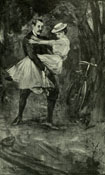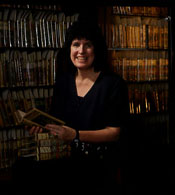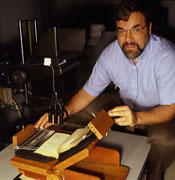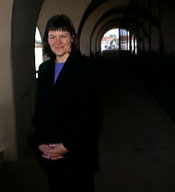“My
dear child! Is it possible that you have never seen or read
of the wheel?”
“The
wheel? What wheel?”
“The
bicycle then—the machine on wheels, that goes faster
than the horse.”
“Ah,
bah! I have heard of people who put the cart before the horse,
and so you are one of them. I shall like to see the wheels
go ahead of—faster than the horse, sir!” Vic laughs
mockingly.
It
takes the lieutenant some time to explain to this untutored
mind the mechanism of the bicycle, and when at last she seems
to comprehend she can talk of nothing else.
“How
perfectly splendid!” she cries. “It must be next
to flying. . . .”
—Lawrence
L. Lynch, Under Fate’s Wheel: A story of mystery,
love, and the bicycle, (Ward, Lock, and Bowden, 1900).
 In
the late nineteenth century, women could often be found sitting
primly around the house in whalebone corsets, determined that
their waist size not exceed their age at marriage. In
the late nineteenth century, women could often be found sitting
primly around the house in whalebone corsets, determined that
their waist size not exceed their age at marriage.
When
the bicycle came on the scene in the 1880s, it was a liberating
vehicle for women, who were suddenly encouraged to get more
fresh air and exercise. And so they put on their bloomers, hiked
up their skirts, and gamely pedaled away, as is recounted in
a cluster of “bicycle stories” in magazines and popular
women’s literature of that era.
“These
are stories about freedom, getting out and seeing things, having
adventures,” says Associate Professor of English Catherine
Nickerson, who discovered the stories while serving as a consultant
on an Emory Women Writers Resource Project on novels written
by women near the turn of the twentieth century.
Then
came bicycle backlash.
“Conservatives
were afraid women who bicycled would fall in with the wrong
crowd, make themselves vulnerable by being so far away from
the house, and might even be raped,” Nickerson says.
Books
like Under Fate’s Wheel (1900), a romance-mystery
by Lawrence L. Lynch—the pseudonym of Emma Murdoch Van
Deventer—reflect this ambiguity by glorifying the new-fangled
vehicle even while including cautionary warnings against it.
“You
must know the Bike has struck the town, not numerously, but
with fervour,” writes older brother in a letter. “Do
you ride a bike, Sis? If you haven’t, don’t. I’ve
ridden bucking broncos, kicking mules, trotters, and—rails,
and the bike can make you ridiculous in more languages, sore
in more places, and dismount you quicker than any animal that
lives. . . . I have ridden the two-wheeled, evilly disposed
demon for the first and last time!”
From
bicycling to suffrage, women’s issues of the day were reflected
in the popular literature, both in hardbound novels and paperbacks
(also called dime novels and “yellowbacks.”) The most
common genres were mystery, crime, and detective novels; wilderness
adventures and Westerns; and tales of suspense, seduction, and
romance.
The
Emory Women Writers Resource Project, in collaboration with
the Victorian Women Writers Project at the University of Indiana,
has been awarded a grant of $314,000 from the National Endowment
for the Humanities (NEH) to create an online database of about
330 of these American and British detective, crime, and romance
novels, authored by women in the late nineteenth and early twentieth
centuries.
The
database fits in well with the mission of the Women Writers
Resource Project, which began in 1995 to enable students to
create electronic editions of early literary works by women.
The project includes significant texts written by early African-American,
native American, abolitionist, and suffragette women, says Masse-Martin/NEH
Distinguished Teaching Professor of English Sheila T. Cavanagh
(below), the project’s director.
 “Students
and scholars from around the world now visit the site to access
material ranging from World War I poetry to the anonymous Memoir
of Elizabeth Jones, A Little Indian Girl,” she says. “Students
and scholars from around the world now visit the site to access
material ranging from World War I poetry to the anonymous Memoir
of Elizabeth Jones, A Little Indian Girl,” she says.
The
Robert W. Woodruff Library already had an impressive collection
of yellowbacks and dime novels, thanks to a few staff visionaries
who realized such novels would someday be rare as well as valued.
In
1960, librarian Marella Walker and Professor of English Harry
Rusche began a serious effort to collect yellowbacks. Ten years
later, Walker arranged to buy the Harold Mortlake Collection
of detective fiction. And in 1996, Emory received the Hugh Greene
Collection (1900 to 1914) and the Graham Greene-Dorothy Glover
Collection of Victorian Detective Fiction (1846 to 1900). In
total, the library has more than eight hundred American and
British yellowbacks.
“The
texts that we will be digitizing are hard for researchers to
find readily,” Cavanagh says. “By placing these novels
on the Web, we are making one of the strengths of our library
more visible while reducing potential wear on the books.”
Being
victims of their own success, many dime novels and yellowbacks
are fragile or in poor repair. In London, readers could rent
a yellowback at one train station and return it at another.
“The cheapness of their medium—a feature that increased
their popularity—facilitates their destruction,” Cavanagh
says. “Many of these texts face imminent extinction.”
Novels
to be included in the database span the decades from the Civil
War to World War I and are set against a backdrop of struggles
over slavery, women’s suffrage, labor unions, urbanization
and industrialization, and changing roles between men and women.
The
database will create a “portal” for research that
allows scholars more efficient ways of analyzing the texts.
“For example, if you want to see how many mentions are
made of Paris, you would just do a search, rather than flipping
through a thousand books,” says Cavanagh.
 Assisting
on the project are the Woodruff Library’s Lewis H. Beck
Center for Electronic Collections and Services and the library’s
preservation and special collections staff. “One of the
reasons we got the grant was that we were committed to preserving
the original books,” says Charles D. Spornick (left), coordinator
of the Beck Center. Assisting
on the project are the Woodruff Library’s Lewis H. Beck
Center for Electronic Collections and Services and the library’s
preservation and special collections staff. “One of the
reasons we got the grant was that we were committed to preserving
the original books,” says Charles D. Spornick (left), coordinator
of the Beck Center.
Novels
that have been selected by the project’s editorial board
are converted to electronic data through a painstaking process.
First, they are placed in an elaborate wooden cradle with plexiglass
arms while they are photographed cover to cover (including inserts,
advertisements, and illustrations) with a $40,000, twelve-megapixel
digital camera. After the high-resolution images are converted
to text using Optical Character Recognition software, proofreading
and encoding typically takes an additional twenty hours p er
novel. er
novel.
Nickerson
(right), for one, can’t wait for the database to be up
and accessible. “I believe popular literature is vastly
under-examined by academics,” she says, “although
there has been a real change in this over the last fifteen years,
with a good body of scholarship emerging on women’s popular
writings, all endeavoring to understand how women articulated
their experiences and lives at the time.”
Like
fiction by Danielle Steel or Mary Higgins Clark today, these
mass-produced novels were considered escapism as opposed to
great literature.
“They
were enormously popular and paid the usual price of this popularity:
to be regarded with suspicion by many stern moralists and to
be sneered at by the supercilious type of critic,” says
Edmund Pearson in Dime Novels: Following an Old Trail in
Popular Literature. “These were to be tales of dread
suspense; of the calm before the storm, but rather more of the
storm than of the calm. In their pages, . . . tons of gunpowder
was to be burned, human blood was to flow in rivers, and the
list of dead men was to mount to the sky.”
Despite
their themes of murder and mayhem, many of the action-packed
novels that swept the country from the 1860s through the 1920s
were written by women—women writing under their married
name, their maiden name, their initials, male pseudonyms, a
“stable” of authors all writing under one name, or
one woman writing under different pseudonyms.
“It
really changes the impression that women’s writing was
all flowery and pretty,” says Nickerson. “There was
a lot of violence.”
Take
this graphic passage from Beatrice Heron-Maxwell’s The
Adventures of a Lady Pearl-Broker (New Century Press, 1899):
Horror.
A woman was lying on the floor, her distorted purple face
bruised and bleeding, her eyes staring upward in mute and
desperate appeal. The lace ruffle around her neck at which
one of her hands was clutching convulsively, had been twisted
and strained with such force, that it looked like a narrow
ragged string on either side of which the flesh rose in two
dark ridges.
Just
below the roiling surface of the narratives, however, ran strong
undercurrents of social commentary.
“These
works were maligned because of their melodrama, their purple
prose, their plot-driven narratives. It’s not Proust,”
says Nickerson. “But why were these novels popular? Because
they struck a nerve. Women were right in the center of defining
what the issues of the day were, both in the U.S. and Britain.
This is a really valuable legacy of women’s writing.”
“What’s
your ideal?” demanded Patience.
“Ideal?
What ideal?”
“Why,
of man, of course.”
“Oh,
man! I haven’t thought much about men. I don’t read
novels, like you do.”
—Patience
Sparhawk and Her Times, by Gertrude Atherton (John Lane, 1897).
It
may seem ironic that novels considered “morally suspect”
in their day and ignored by scholars for so long are now the
focus of such intense academic scrutiny. Even the titles seemed
to discourage serious scholarly discourse: Two Girls and
a Dream, The Devil’s Motor, At the Foot of the Rainbow,
A Woman’s Love Lesson.
“People
wanted something that would grab their attention and keep them
from being bored,” says Nickerson. “These would be
the equivalent of airplane reads today.”
The
stories were populated by orphaned young women with spunk, handsome
Yankee ranchers, mistresses of wealthy men, New York women of
fashion, well-known actresses, high-tempered queens of gambling
houses, dashing naval officers, spinster aunts, insistent suitors,
randy dukes, and haughty duchesses.
“With
this kind of fiction there’s a lot of interest in engaging
the reader with the characters,” says Cavanagh. “Writers
were far less concerned with realism than with whetting the
reader’s appetite for more.”
A
wry sense of humor is apparent in many of the works as they
capture the lofty and occasionally contradictory demands made
of women of the time, while allowing them to transcend gender
barriers by taking on professions and roles usually occupied
by men.
“The
question people frequently ask me, and other scholars of women’s
popular novels, is ‘Are they any good?’ ” says
Nickerson. “I can only answer that I personally find these
novels satisfyingly complex . . . [and] sometimes hilarious
in their feminist wit.”
As
Nickerson states in her scholarly work The Web of Inequity:
Early Detective Fiction by Women (1998), women writing around
the turn of the twentieth century “formulated a style .
. . that drew on the moral force of the domestic novel and the
symbolic language of the gothic mode to critique the gender
and class politics of maturing capitalism.”
These
best-selling novels, she writes, featured women learning about
“corruption and transgression, looking below the placid
surface of things, and questioning appearances.”
Such
invisible machinations are apparent in titles such as The
Unseen Hand, Out from the Night, and Between the Lines.
Investigations and inquiries often take place in the domestic
sphere, signifying the centrality of home and family, but give
insight into the broader, male-dominated worlds of work and
governance.
Detective
and crime stories offer a great deal of information about people’s
fears and anxieties, threats to the social order, and proposed
or hoped-for solutions to these problems.
Sometimes
these fears take form as a “haunted” house, complete
with phantom screams, creaking doors, and ghostly intruders.
This device was used in The Mayor’s Wife (1907)
by Anna Katharine Green, a best-selling and prolific author
who wrote more than sixty detective novels. In it, the lady
of the house has been taken over by a mysterious illness after
seeing an apparition in the library:
“I
was sitting reading . . . oh, I can not think of it without
a shudder!—the page before me seemed to recede and the
words fade away in a blue mist; glancing up, I beheld the
outline of a form between me and the lamp . . . I was conscious
of no substance, and the eyes which met mine from that shadowy,
blood-curdling Something were those of the grave. . . . As
it burned into and through me, everything which had given
reality to my life faded and seemed as far away and unsubstantial
as a dream.”
In
fact, the “ghost” has been manufactured by the mayor’s
wife, who—in a plotline that rivals any contemporary soap
opera—has discovered that her abusive first husband is
not dead, as she thought, but is alive and working for her current
husband, the mayor. The fictional haunting becomes a metaphor
for a personal attachment she can’t escape.
Women,
cast as heroines and villains, investigators and victims, are
“central to these explorations of evil, morality, and justice,”
says Nickerson.
The
genre captures the transition from Victorian to modern times,
as the fairer sex began “asserting themselves politically,
socially, legally, emotionally, and artistically,” she
says. “Over the nineteenth century, the idea of what a
woman was got redefined.”
Indeed,
contemporary women may discover they owe much to the fearless
young girl in Lynch’s novel who “set the wheels of
Fate in motion by running away from home to be a bicycle rider.”
For
more information about the Emory Women Writers Resource Project,
go to http://chaucer.library.emory.edu/wwrp/.
To find out more about the Lewis H. Beck Center for Electronic
Collections and Services, go to http://chaucer.library.emory.edu/.
|